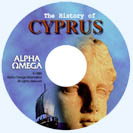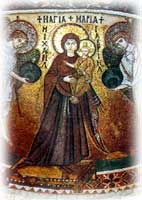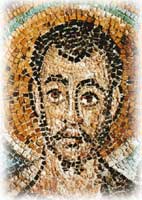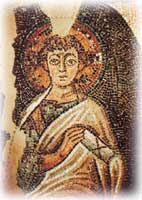 |
||
|
The Mosaics of Panagias Aggeloktistis, Kanakarias and Kyras When Christianity was acknowledged initially as a religion and secondly as the official religion of Cyprus, people, in their efforts to come closer to God, began to built glorious churches. Architecture provided the place for the worship and painting brought forth the triumph of Christianity through the life of Christ and the Holy Men. There arenít many wall paintings left from the pre-Byzantine era because their durability against time is not great. On the contrary, there are many mosaics saved which witness the brilliance, the greatness and the beauty of our churches. All of the Mosaics that are saved in Cyprus belong in the pre-Byzantine era. The 6th century AD is the beginning of flourish of the Byzantine Art. In Cyprus there was a great influence by Costantinoupolis (Istanbul) but later on the development of this art was affected by the historical events that took place on the island. The art of the mosaic was well developed in Cyprus due to the fact that there wasnít any marble and imports of marble began in the 7th century AD. Unfortunately, in the time of iconoclasm there were many ruins of great art pieces but valuable mosaics are saved:
In the Panagia Aggeloktisti Church at Kiti, the mosaic at the apse is estimated that it was built at the end of the 6th century. It shows Virgin Mary to be standing and holding little Christ with Her left hand. Her right hand touches Christís knee in a way that can be considered as the precursory type of Panagias Odigitrias. Virgin Mary and Christ are surrounded by Archangel Michael (left) and Archangel Gabriel (right). The whole synthesis is enclosed by a decorated mosaic crown where the maim themes come from the joy of life. The Archangels to the left and right are holding a staff and a sphere and are moving towards Virgin Mary with peacock wings. This specifies the type of Panagias Odigitrias and itís considered as the reason for many discussions between style specialists. The technique and the style of the mosaic is compared with the mosaic of Empress Theodora in the apse of the temple of Agios Vitalios in Raven (Italy-6th century AD).
The church of Panagia Kanakaria is located in Lythragomi and is considered to be the most ancient synthesis of mosaic of the specific type. The mosaics of Kanakaria are extremely significant because their iconographical characteristics are unique. The mosaic shows Virgin Mary to hold little Christ on Her knees. Unfortunately, Her head is not saved. The enthroned Virgin Mary was surrounded by a "luminous glory" with the colours of iris along with a heavenly landscape with palm trees and other plants. Archangels Michael and Gabriel once more surround Virgin Mary and Christ. Although the frontal posture and the wide opened eyes are elements of Eastern Art, the combination of the above with the attribution of bodies and clothes specify the Hellenic Art. Unfortunately, the Turkish barbarism, due to the Turkish invasion in 1974, destroyed this exceptionally important mosaic. The Turks, in their attempt to obliterate everything that is considered Greek, lopped the mosaic from the apse of the church in a barbaric way and tried to sell it abroad. It was an unprecedented crime not only against Cyprus but also against the global cultural heritage. The Turks exported parts of the mosaic in Munich, Germany, but fortunately they were returned to Cyprus after the intervention of a London art dealer. The two repatriated mosaics portrayed Evangelist Loukas and Apostle Bartolomeos. In 1988, an art dealer in Indianapolis of United States bought the upper part of Christ and the medals with the figures of Apostle Iakovos (Jacob) and Matheos (Matthew) from a Turkish illicit dealer. The Cyprus Government and the Cyprus Church sued the US art dealer and demanded the returned of the stolen mosaics. In 1991, judge James Nolard ordered the return of the mosaics to the legal holder, the Orthodox Church of Cyprus.
The part of the mosaic saved displays Virgin Mary standing over a rectangular footstool with Her hands raised, without holding Christ, indicating a prayer posture. The head, the left shoulder and the left hand have not been saved. Virgin Mary was pictured on a golden throne with two Archangels. The Turks destroyed the mosaic because of a fire in 1982. From a technical point of view, the mosaics of Panagias Aggeloktistis and Panagias Kyras are unique because very small inlays were used, particularly for the naked parts of the body. It is so estimated that the date of construction of the two mosaics is approximately the same (end of 6th century-beginning of 7th). The mosaic of Panagias Kyras is very destroyed and it doesnít have the significance of the other two. From an art point of view, the mosaic of Panagias Aggeloktistis is more important than the one of Panagias Kyras whereas the mosaic of Panagias Kanakarias is the most important from an iconographic point of view. |
 | |



